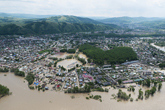Flooding hits southern Siberia and Russian Far East

Thousands forced to flee their homes following heavy rainfalls. Source: RIA Novosti
Photo-gallery. Source: RIA Novosti
In just a few days, heavy rains caused rivers to burst their banks in the southern Siberian regions of the Altai Territory, the Altai Republic and the Republic of Khakassia. According to the Russian Ministry of Emergency Situations, 6,700 homes are now flooded as a result, and over 20,000 people have been evacuated to temporary shelters. Six people were killed and many remain missing.
On Tuesday morning, the official websites of the regional administrations reported that water levels had gone down in almost all the rivers of the Altai Republic and the Altai Territory, and residents were beginning to return to their homes. However, it was later reported that water levels in the Ob River in Barnaul (the capital of the Altai Territory) had begun rising again.
The aftermath of the tragedy
Over 3,000 homes, from which 7,500 people have been evacuated, remain flooded in the Altai Territory. Residents were still trying to save their property when the flooding began, but by the weekend it had become clear that the flooding was a question of life and death. Despite this, many did not retreat in the onslaught of the flood and chose instead to remain in their homes.
Viktor Yeremeyev is one of the residents of the flooded villages who have refused to leave their homes. His wife brings him a thermos with hot tea, sandwiches, and other food by boat every day. According to her, nothing can persuade her husband to leave the house.
Yelena Malougrenevo found herself in a similar situation. As she said in an interview with local media, the water level began to rise quickly, and the attic, which she had originally thought would be her salvation, became a deadly trap. The woman was trapped in her own house with her two children. With water levels rising rapidly, she could not wade through the flooded village. Luckily, emergency workers arrived in time to help the family out of the house.
Many people criticized rescue teams for being too slow to act. Not surprisingly, when you are counting every minute and are stuck on the roof of your house without water and bread, you begin to expect more from the authorities – in some cases, even miracles.
For three days, the faces of the rescue team remained the same. The same men and women, without breaking for sleep or meals, moved from village to village, hoping that they would make it in time. In most cases, they were successful. So far, the most devastating flood the region has seen in the past 50 years has claimed the lives of six people. Many residents who had inflatable boats and immersion survival suits volunteered and are now helping people along with the rescuers.
Meanwhile, Russian Prime Minister Dmitry Medvedev has instructed the government to assess the damage from the floods in Siberia to determine how much compensation to provide for the victims. The money will be allocated from the federal budget.
Earlier, Emergency Situations Minister Vladimir Puchkov reported that compensation payments from the federal budget will begin this week. Residents of the Altai Territory who were most affected by the flooding are already receiving compensation.
Meanwhile, the Far East has fallen victim to severe floods for the second year in a row. In the Amur Region, 126 towns have been flooded. About 8,000 houses, covering a population of 37,000 people (including more than 10,000 children), are under water.
Reasons for the flooding
Head of the Hydrometeorology and Environmental Monitoring Agency Yury Varakin noted that abnormal changes in the circulation of air masses over the south of Siberia and the Russian Far East, which may become permanent, were primarily responsible for the floods.
"Thus, in the beginning of July 2013, a stationary high altitude atmospheric front formed over Priamurye. For two months, large cyclones rich with tropical moisture and accompanied by heavy rain moved along the atmospheric front, which resulted in the Amur Region and the Jewish Autonomous Region getting more than the usual amount of precipitation from July to August of last year," said Varakin.
Viktor Usov, the executive director of the Russian National Committee for the United Nations Environment Program, also shared this point of view. According to him, there are cyclical processes at work that are made worse by man-made factors. Usov said that it was impossible to predict the flooding with 100 percent accuracy, but that Russian and foreign scientists do have innovations designed to help minimize flood damage. As of today, such innovations are not in high demand.
In 2013, more than 10 billion rubles ($288 million) in agricultural damage was incurred from flooding in the Far East. The water reservoirs of the Zeiskaya and Bureiskaya hydroelectric power stations completely filled up, and water began to spill over the dams.
All rights reserved by Rossiyskaya Gazeta.
Subscribe
to our newsletter!
Get the week's best stories straight to your inbox

